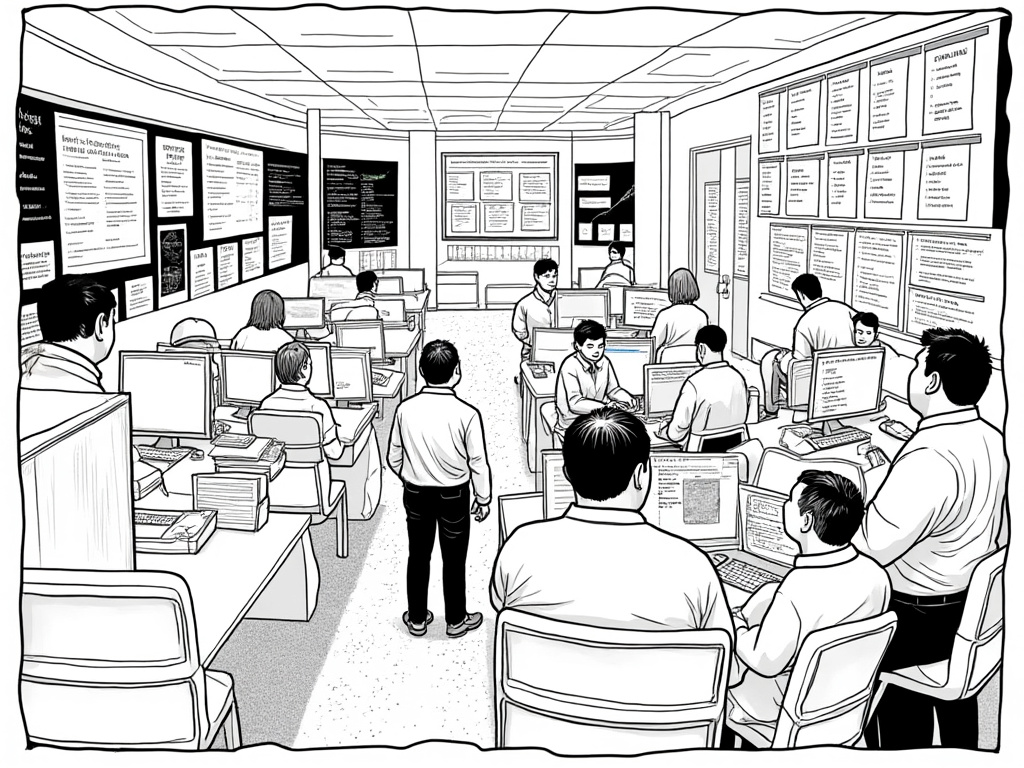
UAE Space Data Center: Pioneering the Future of Cosmic Research
Reading time: 12 minutes
Table of Contents
- The Emergence of UAE’s Space Ambitions
- Inside the UAE Space Data Center
- Revolutionary Research Capabilities
- Global Partnerships and Collaborative Frameworks
- Economic and Scientific Impact
- Navigating Challenges in Space Data Management
- Looking Beyond Earth’s Horizon
- Frequently Asked Questions
The Emergence of UAE’s Space Ambitions
Remember when the UAE was primarily known for its architectural marvels and petroleum industry? That narrative has dramatically evolved. The nation that once gazed up at skyscrapers now reaches for the stars with equal ambition.
The UAE Space Data Center represents not just a facility, but a fundamental shift in the Middle East’s scientific landscape. Established as part of the UAE’s comprehensive space strategy, this center emerges at a critical juncture when space data has become the new frontier of knowledge economics.
Dr. Sarah Al-Amiri, Minister of State for Advanced Technology and Chairwoman of the UAE Space Agency, explains: “The Space Data Center isn’t merely about storing information—it’s about transforming raw cosmic data into actionable insights that drive innovation across multiple sectors of our economy.”
This transformation didn’t happen overnight. The UAE’s journey began with the establishment of the Mohammed Bin Rashid Space Centre in 2006, accelerated with the successful launch of KhalifaSat in 2018, and reached a milestone with the Hope Probe’s Mars orbit insertion in 2021. Each step built the necessary expertise and infrastructure that culminated in this dedicated data center.
Inside the UAE Space Data Center
Architectural and Technological Marvels
Situated in Abu Dhabi’s Masdar City, the UAE Space Data Center spans 15,000 square meters of cutting-edge infrastructure. The building itself is a testament to sustainable design, powered by a 2.5 MW solar array that provides 40% of its considerable energy needs while maintaining the precise environmental controls required for sensitive computing equipment.
At its core, the facility houses a supercomputing cluster capable of processing 16 petaflops—equivalent to 16 quadrillion calculations per second. This computational powerhouse enables researchers to process massive datasets from satellite imagery, Mars missions, and deep space observations.
The storage infrastructure is equally impressive, with an initial capacity of 20 petabytes expandable to 50 petabytes. This allows for the archiving of historical mission data alongside new incoming streams from active projects.
Data Acquisition Systems
The center receives data through three primary channels:
- Direct satellite downlinks through a network of ground stations distributed strategically across the UAE
- International space agency partnerships that facilitate data sharing from missions like the International Space Station
- Deep space communication arrays that maintain contact with missions beyond Earth orbit, such as the Hope Probe
Once received, data undergoes initial processing through specialized pipelines designed for different data types. Earth observation imagery, for instance, requires atmospheric correction and geospatial referencing, while Mars data demands specialized calibration protocols.
Let’s consider a practical example: When the Hope Probe sends back atmospheric readings from Mars, the raw telemetry arrives as encrypted data packets. The center’s processing pipeline decrypts these packets, converts the readings to standardized units, applies calibration algorithms specific to each instrument, and finally stores them in formats accessible to researchers.
Revolutionary Research Capabilities
Earth Observation Applications
One of the center’s primary functions involves Earth-focused research with immediate practical applications. The facility processes data from a constellation of UAE satellites as well as those from international partners.
Case study: Following a particularly severe sandstorm in 2022, the center analyzed multispectral imagery to assess agricultural impact across the Gulf region. By processing historical vegetation indices alongside new data, researchers identified vulnerable areas and helped authorities target remediation efforts more effectively. This rapid response capacity prevented an estimated $14 million in crop losses.
The center’s capabilities extend to:
- Urban development monitoring with 30cm resolution imaging
- Oil spill detection and tracking using radar satellite data
- Water resource management through hydrological modeling
- Climate change impact assessment with multi-decade datasets
Deep Space and Planetary Science
Beyond Earth’s immediate vicinity, the center processes data from the UAE’s ongoing and future planetary missions. The Hope Probe continues to send unprecedented observations of Mars’ atmosphere, with the center housing the complete dataset and processing capabilities.
Dr. Hessa Al Matroushi, Emirates Lunar Mission Science Lead, notes: “The processing requirements for planetary data are uniquely challenging. A single day of observations from our Mars mission generates terabytes of raw data that require specialized algorithms and contextual knowledge to interpret.”
The center has pioneered several analytical approaches, including:
- Neural network applications for detecting subtle patterns in Martian weather systems
- Volumetric analysis of atmospheric gas distributions around the red planet
- Comparative modeling between Earth and Mars climate systems
- Surface feature recognition algorithms for future lunar missions
UAE Space Missions Data Processing Requirements
Data volume in petabytes (PB) processed annually at the UAE Space Data Center, represented as percentage of total processing capacity
Global Partnerships and Collaborative Frameworks
International Space Agency Integration
The UAE Space Data Center operates on a principle of strategic openness, forming partnerships with major space agencies worldwide. These collaborations transcend simple data sharing, encompassing joint research initiatives, technical staff exchanges, and shared computing resources.
Key partnerships include:
| Partner Agency | Collaboration Focus | Shared Resources | Joint Projects | Technology Exchange |
|---|---|---|---|---|
| NASA (USA) | Mars Exploration | 16 TB/month | Mars Weather Prediction | Deep Learning Frameworks |
| ESA (Europe) | Earth Observation | 22 TB/month | Climate Monitoring Initiative | Processing Algorithms |
| JAXA (Japan) | Lunar Research | 8 TB/month | Regolith Analysis | 3D Mapping Tools |
| ISRO (India) | Satellite Technology | 12 TB/month | Agricultural Monitoring | Machine Learning Models |
These partnerships function through standardized data exchange protocols and regular coordination meetings. For example, the center works directly with NASA’s Jet Propulsion Laboratory to synchronize Mars observations between the Hope Probe and NASA’s Perseverance rover, providing complementary datasets that neither mission could capture alone.
Academic and Private Sector Engagement
Beyond government space agencies, the center has established a robust framework for collaboration with universities and private companies. The UAE Space Research Access Program provides structured pathways for external researchers to utilize the center’s resources.
This program operates on three tiers:
- Open Access – Basic datasets and limited computing resources available to all qualified researchers globally
- Collaborative Access – Enhanced resources for joint research projects with UAE institutions
- Strategic Partnership – Full infrastructure access for deep, long-term research collaborations
The real-world impact of this approach is evident in projects like the Gulf Water Quality Initiative. This collaboration between the center, three regional universities, and a private environmental monitoring firm developed new methods to detect harmful algal blooms using multispectral satellite data. The resulting early warning system now protects desalination plants that supply drinking water to millions.
Economic and Scientific Impact
The UAE Space Data Center isn’t just advancing science—it’s creating a new economic ecosystem around space data. The center has catalyzed the formation of over 40 space-related startups in the region since its inception, creating a specialized job market for data scientists, aerospace engineers, and planetary researchers.
Ibrahim Al-Hassan, Director of Economic Development at the UAE Space Agency, shares: “We’ve witnessed a 32% annual growth in space sector employment since the center launched. These aren’t just research positions—they’re high-value technical roles that strengthen our knowledge economy while addressing practical challenges here on Earth.”
The economic ripple effects extend to sectors that traditionally had no connection to space technology:
- Agricultural companies now use satellite-derived soil moisture maps to optimize irrigation
- Insurance firms incorporate weather pattern analysis into risk assessment models
- Urban planners utilize thermal mapping to design more energy-efficient cities
- Healthcare facilities correlate environmental data with public health trends
Recent analysis estimates that for every dirham invested in the center, approximately 3.6 dirhams of economic activity are generated across associated industries.
Navigating Challenges in Space Data Management
Technical and Operational Hurdles
Despite its achievements, the UAE Space Data Center faces significant challenges. The exponential growth in data volume presents perhaps the most immediate concern. With each new mission and sensor generation, data resolution and collection frequency increase—the center’s current 20 petabyte storage infrastructure is projected to reach 80% capacity by 2025, two years ahead of original estimates.
The center is addressing this through a dual strategy:
- Implementing intelligent data compression algorithms that reduce storage requirements by 40-60% while maintaining scientific value
- Developing tiered storage architecture that automatically migrates less-frequently accessed data to more cost-effective media
Additionally, power consumption remains a persistent challenge. The computational requirements for processing celestial mechanics simulations and complex atmospheric models demand enormous energy resources. The center’s sustainability team works continuously to balance performance needs with environmental responsibility.
Knowledge Transfer and Capacity Building
Perhaps more challenging than the technical aspects is developing human expertise. The UAE’s space program is relatively young, and building specialized knowledge in fields like planetary science requires time.
Dr. Mohammed Al-Ahbabi, former Director-General of the UAE Space Agency, acknowledges this reality: “We recognized early that technology transfer would be insufficient without knowledge transfer. Our partnerships emphasize skill development alongside data sharing.”
The center has implemented several initiatives to address this gap:
- The Space Data Science Fellowship that sponsors 15 UAE nationals annually for specialized graduate studies abroad
- A visiting researcher program that brings international experts for 3-6 month residencies
- Specialized training programs developed with partner agencies like NASA and ESA
- Regular workshops and hackathons focused on specific data analysis challenges
This approach has shown promising results, with 72% of key technical positions now filled by UAE nationals, compared to just 23% when the center launched.
Looking Beyond Earth’s Horizon
The UAE Space Data Center has an ambitious roadmap that extends well into the next decade. Plans include:
- Expanding computational capacity to 30 petaflops by 2026
- Developing specialized AI systems for autonomous data classification
- Establishing a dedicated quantum computing facility for complex space simulations
- Creating a virtual reality interface for immersive data exploration
These technological expansions support the UAE’s broader space objectives, including:
The Mars 2117 Initiative – The center will serve as the primary data hub for the UAE’s long-term vision to establish a human settlement on Mars. This includes processing environmental data needed to design life support systems and habitats suitable for the Martian environment.
Asteroid Mining Research – A newly formed division focuses on processing spectroscopic data to identify resource-rich near-Earth objects and develop extraction methodologies.
Exoplanet Characterization – In partnership with international observatories, the center is developing specialized algorithms to analyze atmospheric signatures of planets orbiting other stars.
Your Launchpad to UAE’s Cosmic Data Revolution
The UAE Space Data Center stands at the crossroads of ambition and achievement—a testament to what focused national investment in science and technology can accomplish. For researchers, entrepreneurs, and policy makers, the center offers pathways to engage with one of humanity’s greatest frontiers.
Action Steps for Engagement:
- Researchers: Apply for access through the UAE Space Research Access Program, with quarterly application windows for international collaborators
- Startups: Explore the Space Data Innovation Hub incubator program, which provides both technical resources and potential seed funding
- Students: Consider the annual Space Data Science Internship Program, accepting applications from both domestic and international candidates
- Industry Partners: Contact the center’s Technology Transfer Office to discuss specific data utilization opportunities for commercial applications
The democratization of space data represents one of the most significant scientific opportunities of our generation. As Dr. Al-Amiri eloquently states: “Space may be infinite, but our window to understand it is not. The data we gather today will inform decisions for decades to come.”
Have you considered how cosmic data might transform your field? Whether you’re in agriculture, urban planning, environmental science, or medicine, the insights from above offer perspectives impossible to gain from the ground. The question isn’t whether space data will transform your industry—it’s whether you’ll be ready when it does.
Frequently Asked Questions
How can international researchers gain access to the UAE Space Data Center?
International researchers can access the center’s resources through the UAE Space Research Access Program, which offers three tiers of engagement. The basic “Open Access” tier is available to all qualified researchers following a straightforward application process that evaluates research objectives and technical requirements. For more extensive resource needs, researchers should consider the “Collaborative Access” tier, which requires partnership with a UAE-based institution. Applications are reviewed quarterly, with decisions typically provided within 60 days. The center particularly welcomes proposals focusing on cross-disciplinary applications of space data.
What types of space data are available through the center?
The center houses diverse datasets including high-resolution Earth observation imagery (optical, infrared, and radar), Mars atmospheric and surface observations from the Hope Probe, lunar topographical measurements, and astronomical data from various observatories. Earth observation data includes historical archives dating back to 1985 through partnerships with international agencies, offering valuable longitudinal data for climate research. The Mars dataset includes unique atmospheric measurements not captured by other missions, particularly focusing on diurnal variations and dust storm patterns. All datasets are maintained with comprehensive metadata and standardized formats to facilitate cross-mission analysis.
How does the UAE Space Data Center compare to similar facilities operated by NASA or ESA?
While NASA and ESA operate larger overall infrastructures, the UAE Space Data Center offers several distinctive advantages. First, its newer infrastructure incorporates the latest technologies without legacy system constraints. Second, the center specializes in integrated data analysis across multiple missions and agencies, whereas older facilities often maintain mission-specific processing pipelines. Third, the UAE center emphasizes applications and commercial development more strongly than some research-focused institutions. The center’s computational capacity (16 petaflops) is comparable to mid-tier facilities at larger agencies, though specialized for space data processing rather than general scientific computing. The center maintains direct data exchange protocols with both NASA and ESA facilities, enabling researchers to access complementary resources when needed.

Article reviewed by Daniel Costa, Agribusiness Analyst | Studying UAE-Brazil Trade Flows, on May 15, 2025
